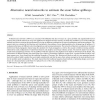Free Online Productivity Tools
i2Speak
i2Symbol
i2OCR
iTex2Img
iWeb2Print
iWeb2Shot
i2Type
iPdf2Split
iPdf2Merge
i2Bopomofo
i2Arabic
i2Style
i2Image
i2PDF
iLatex2Rtf
Sci2ools
100
Voted
AES
2008
Springer
2008
Springer
Alternative neural networks to estimate the scour below spillways
Artificial neural networks (ANN's) are associated with difficulties like lack of success in a given problem and unpredictable level of accuracy that could be achieved. In every new application it therefore becomes necessary to check their usefulness vis-a`-vis the traditional methods and also to ascertain their performance by trying out different combinations of network architectures and learning schemes. The present study was oriented in this direction and it pertained to the problem of scour depth prediction for ski-jump type of spillways. It evaluates performance of different network configurations and learning mechanisms. The network architectures considered are the usual feed forward back propagation trained using the standard error back propagation as well as the cascade correlation training schemes, relatively less used configurations of radial basis function and adaptive neuro-fuzzy inference system. The network inputs were characteristic head and discharge intensity over...
| Added | 08 Dec 2010 |
| Updated | 08 Dec 2010 |
| Type | Journal |
| Year | 2008 |
| Where | AES |
| Authors | H. Md. Azamathulla, M. C. Deo, P. B. Deolalikar |
Comments (0)

